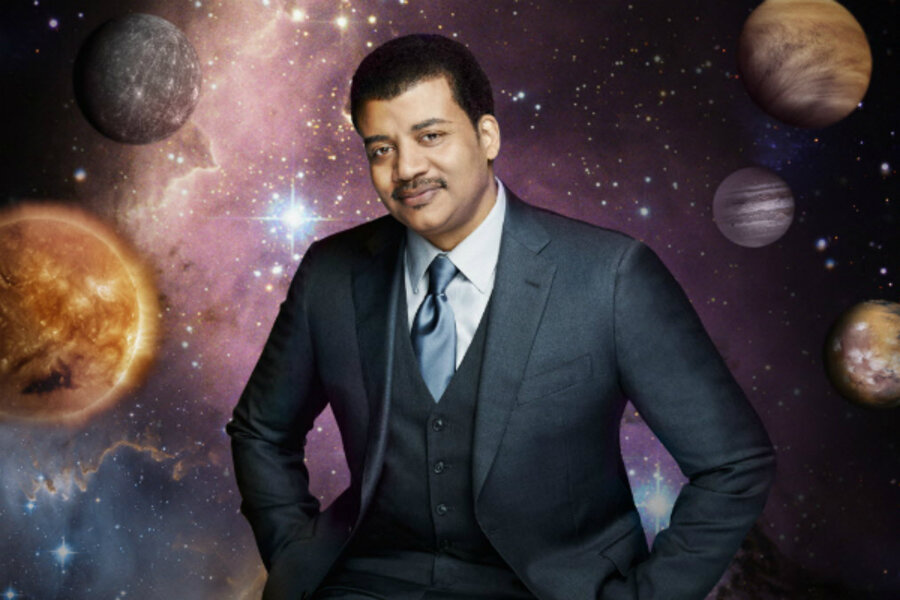'Cosmos': Can Fox reboot shine amid 'billions and billions' of options?
Loading...
| LOS ANGELES
Frankly, science literacy is probably the last term anyone would use to describe Fox’s primetime programming. Yet, here is the network home of “Family Guy,” touting “Cosmos: A Spacetime Odyssey,” its remake of the most definitive science TV series ever, Carl Sagan's 1980 “Cosmos, A Personal Journey” on PBS
The series is actually executive produced by Seth MacFarlane of “Family Guy” fame, in partnership with Ann Druyan, Mr. Sagan’s widow and a co-writer of the original "Cosmos" series. "Cosmos," the sequel, will also air on National Geographic, beginning Monday. But the real question is: Can this concept, originally headlined by science’s first rock star in a largely pre-cable universe (only 23 percent of homes even had cable back then) make a dent in today’s media universe, where as Sagan might say, there are “billions and billions” of options?
Some early returns are in: 8.5 million viewers across 10 channels tuned in for the debut, according to the Wrap. Fox is projecting that more than 40 million viewers worldwide will have seen the debut of the new series by week's end
The series debuted with a few things in its favor. Let’s see. The president of the United States, Barack Obama, stepped in to give a surprise introduction when the series debuted Sunday. And the unprecedented, multiplatform blitz strategy helped spread the word. In addition to re-airing on Nat Geo, the show launched on Fox and 10 sister cable channels simultaneously.
While some might think the very notion of TV is too retro in a world going increasingly mobile, this kind of extravagant, special-effects-heavy programming needs to be seen on the big home screen, says Fordham University professor Paul Levinson, author of “New New Media.”
"Television is the ideal place for a relaunch of the Sagan 'Cosmos' series,” he says via e-mail, because it’s the biggest screen in the home and is easily seen by the family or friends at the same time.
“The 'Cosmos,' as a subject, requires a screen bigger than the phone, tablet, or laptop, and its profundity makes it a perfect subject for group viewing and discussion, which can take place any time of night or day thanks to DVRs,” he notes. As we go about our busy lives down here on Earth, he adds, “it is more important than ever that we get a sense of the larger universe in which we are situated, and how that relates to our past and our future."
The scientific community has welcomed the show, praising host Neil deGrasse Tyson. “The new 'Cosmos' show is great,” writes Villanova University astronomy professor Edward Guinan from Philadelphia. Mr. Tyson has a great talent for explaining difficult science concepts, such as “dark energy and matter,” in clear and interesting ways, he notes. “He also has a great sense of humor that will enliven the show.”
Across campus, Villanova Communication Instructor Derek Arnold notes that the show faces formidable competition. Not just from many other entertainment alternatives, but a vast universe of nature and science programming as well, on everything from the Science Channel to a multitude of Discovery and PBS shows, to name a few.
However, he points out that Tyson may be the ideal successor to Sagan. “One of my sons [who is 15] sees him as his favorite public figure,” he says via e-mail. Tyson can energize viewers with his delivery and also serve as a popular spokesperson for science in general, he says.
Just as Sagan was a pop culture figure, appearing on " 'The Tonight Show with Johnny Carson,' so Tyson has made himself a fixture on such late-night destinations as “'The Daily Show,' ” says Robert Thompson, founder of the Bleier Center for Television and Popular Culture in Syracuse, N.Y.
“He pointed out to the host Jon Stewart that the turning world in his opening credits was going the wrong direction,” he says with a laugh. He also famously posited a list of scientifically incorrect faux pas committed in the movie, “Gravity,” which included the fact that Sandra Bullock’s hair would have been loosely flying, rather than the utterly controlled mane that appeared in the movie.
More than being well-adapted to the media environment of today, Tyson helps feed a critical science literacy into popular culture, Professor Thompson adds.
Sagan’s show tapped into a pop culture obsession with extraterrestrial life, notes Thompson, pointing to such films as “E.T.” and “Close Encounters of the Third Kind.”
The new show introduces heady topics such as string theory and parallel universes, “which are real scientific topics, making their way into water-cooler chats.”
There are very few important geopolitical decisions these days that do not have a science component, he says, “but we remain a nation that is science and math phobic, so anything that helps feed real science into the public dialogue is a good thing.”
Not all scientists were thrilled with the content, however. John Janovy, professor emeritus of biological sciences at University of Nebraska, Lincoln found it “a little bit shallow and non-engaging.” Mainly, he says via e-mail, “because I did not see the essential structure of science, namely a question followed by an attempt to answer it, as part of the narrative.”
And what does PBS, the rightful progenitor, make of a mainstream cable broadcast network recreating its most-watched science show ever?
“The new 'Cosmos' certainly points back to the power and importance of the original,” says Beth Hoppe, PBS chief programming executive. And, she adds, “we are always happy to see good science content, even if it’s on other channels.”





